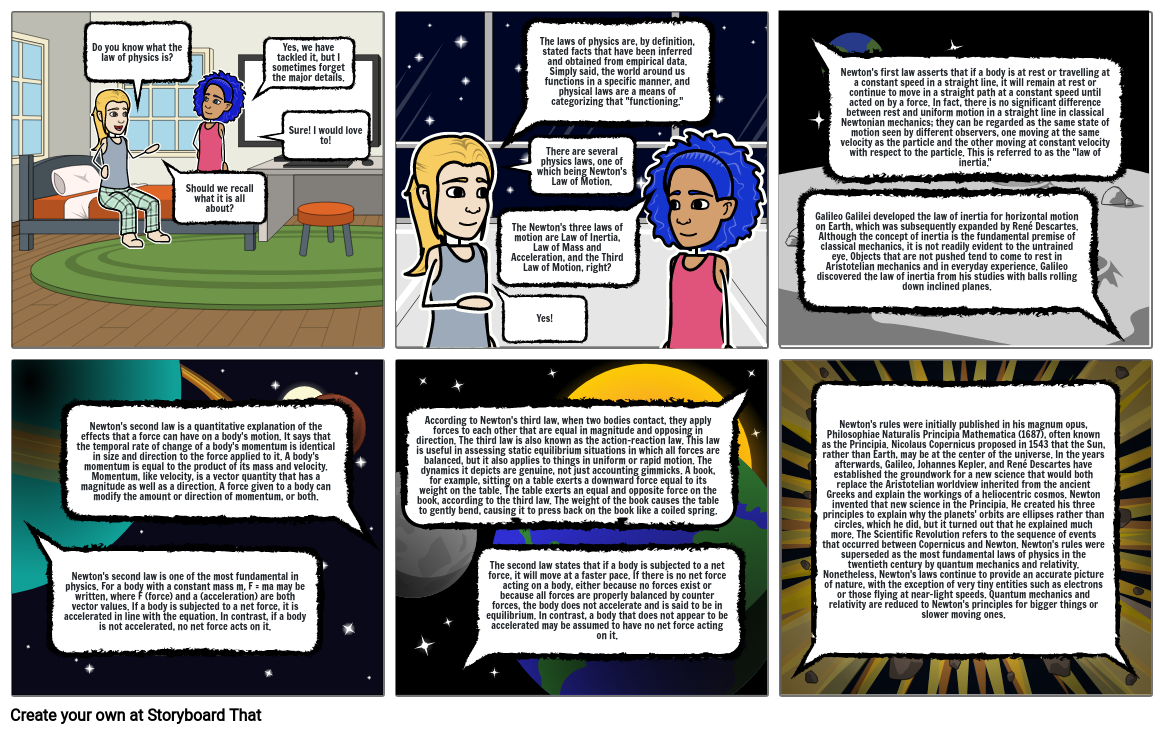LAW OF PHYSICS

Storyboard Tekst
- Do you know what the law of physics is?
- Should we recall what it is all about?
- Yes, we have tackled it, but I sometimes forget the major details.
- Sure! I would love to!
- Yes!
- The Newton's three laws of motion are Law of Inertia, Law of Mass and Acceleration, and the Third Law of Motion, right?
- There are several physics laws, one of which being Newton's Law of Motion.
- The laws of physics are, by definition, stated facts that have been inferred and obtained from empirical data. Simply said, the world around us functions in a specific manner, and physical laws are a means of categorizing that "functioning."
- Galileo Galilei developed the law of inertia for horizontal motion on Earth, which was subsequently expanded by René Descartes. Although the concept of inertia is the fundamental premise of classical mechanics, it is not readily evident to the untrained eye. Objects that are not pushed tend to come to rest in Aristotelian mechanics and in everyday experience. Galileo discovered the law of inertia from his studies with balls rolling down inclined planes.
- Newton's first law asserts that if a body is at rest or travelling at a constant speed in a straight line, it will remain at rest or continue to move in a straight path at a constant speed until acted on by a force. In fact, there is no significant difference between rest and uniform motion in a straight line in classical Newtonian mechanics; they can be regarded as the same state of motion seen by different observers, one moving at the same velocity as the particle and the other moving at constant velocity with respect to the particle. This is referred to as the "law of inertia."
- Newton's second law is one of the most fundamental in physics. For a body with a constant mass m, F = ma may be written, where F (force) and a (acceleration) are both vector values. If a body is subjected to a net force, it is accelerated in line with the equation. In contrast, if a body is not accelerated, no net force acts on it.
- Newton's second law is a quantitative explanation of the effects that a force can have on a body's motion. It says that the temporal rate of change of a body's momentum is identical in size and direction to the force applied to it. A body's momentum is equal to the product of its mass and velocity. Momentum, like velocity, is a vector quantity that has a magnitude as well as a direction. A force given to a body can modify the amount or direction of momentum, or both.
- According to Newton's third law, when two bodies contact, they apply forces to each other that are equal in magnitude and opposing in direction. The third law is also known as the action-reaction law. This law is useful in assessing static equilibrium situations in which all forces are balanced, but it also applies to things in uniform or rapid motion. The dynamics it depicts are genuine, not just accounting gimmicks. A book, for example, sitting on a table exerts a downward force equal to its weight on the table. The table exerts an equal and opposite force on the book, according to the third law. The weight of the book causes the table to gently bend, causing it to press back on the book like a coiled spring.
- The second law states that if a body is subjected to a net force, it will move at a faster pace. If there is no net force acting on a body, either because no forces exist or because all forces are properly balanced by counter forces, the body does not accelerate and is said to be in equilibrium. In contrast, a body that does not appear to be accelerated may be assumed to have no net force acting on it.
- Newton's rules were initially published in his magnum opus, Philosophiae Naturalis Principia Mathematica (1687), often known as the Principia. Nicolaus Copernicus proposed in 1543 that the Sun, rather than Earth, may be at the center of the universe. In the years afterwards, Galileo, Johannes Kepler, and René Descartes have established the groundwork for a new science that would both replace the Aristotelian worldview inherited from the ancient Greeks and explain the workings of a heliocentric cosmos. Newton invented that new science in the Principia. He created his three principles to explain why the planets' orbits are ellipses rather than circles, which he did, but it turned out that he explained much more. The Scientific Revolution refers to the sequence of events that occurred between Copernicus and Newton. Newton's rules were superseded as the most fundamental laws of physics in the twentieth century by quantum mechanics and relativity. Nonetheless, Newton's laws continue to provide an accurate picture of nature, with the exception of very tiny entities such as electrons or those flying at near-light speeds. Quantum mechanics and relativity are reduced to Newton's principles for bigger things or slower moving ones.
Over 30 millioner storyboards opprettet

